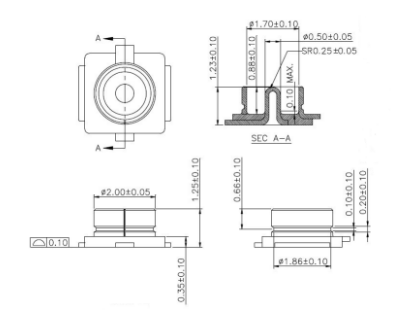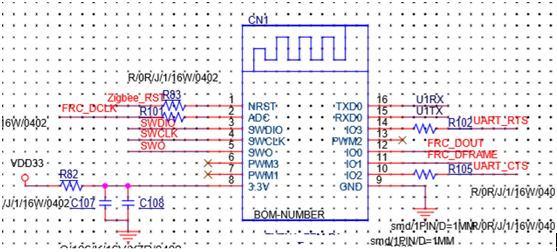TYZS4-IPEX Module Datasheet
Last Updated on : 2024-06-14 03:09:01download
TYZS4-IPEX is a low-power embedded Zigbee module that Tuya has developed. It consists of a highly integrated RF processing chip (EFR32MG1B232F256GM48-D), a few peripherals, a built-in 802.15.4 PHY/MAC Zigbee network protocol stack, and rich library functions.
Overview
TYZS4-IPEX is embedded with a low-power 32-bit ARM Cortex-M4 core, 256-KB flash memory, 32-KB RAM, and abundant peripheral resources.
Features
- Embedded with a low-power 32-bit ARM Cortex-M4 core with DSP instructions and floating-point units, which can also work as a processor
- The clock rate: 40 MHz
- Wide working voltage: 2.2 to 3.8 V
- Peripherals: 4 GPIOs and 1 UART (flow control)
- Zigbee working features:
- Support 802.15.4 MAC/PHY
- Working channels 11 to 26@2.400 to 2.483 GHz Air interface rate: 250 Kbps
- Built-in DC-DC circuit, which improves the power efficiency to the greatest extent
- Up to + 19dBm output power
- 60 uA/MHz power consumption during running, 1.4uA sleep current
- Ipex connector, which can be used together with multiple external antennas
- Working temperature: -40℃ to 85℃
- Support hardware encryption and AES 128/256
- Support wireless packet capture
Applications
- Intelligent building
- Smart household and home appliances
- Smart socket and light
- Industrial wireless control
- Health and measurement
- Asset tracking
Module interfaces
Dimensions and package
TYZS4-IPEX has 2 rows of pins with a 2 mm pin spacing.
The dimensions of TYZS4-IPEX are 21±0.35 mm (W)×28±0.35 mm (L) ×3.5±0.15 mm (H).
The dimensions of TYZS4-IPEX are as follows:
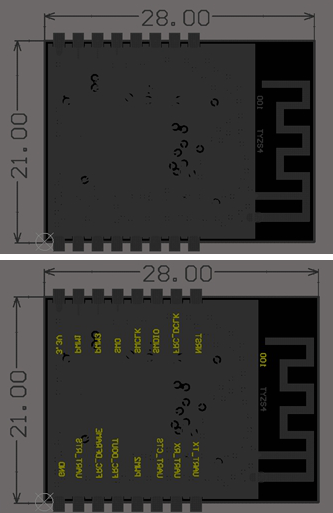
Pin definition
The definitions of pins of TYZS4-IPEX are shown in the following table:
| Pin number | Symbol | I/O type | Function |
|---|---|---|---|
| 1 | nRST | I | Hardware reset pin, the chip is reset at the low level; the module has its own power-on reset, and users may not use this pin according to the actual situation. |
| 2 | FRC_DCLK | I/O | packet trace interface (PTI), which corresponds to PB11 |
| 3 | SWDIO | I/O | Communication interface for JLINK burning, which can be configured as a GPIO in the application and corresponds to PF1 |
| 4 | SWCLK | I/O | Clock signal of JLINK burning, which can be configured as GPIO in the application and corresponds to PF2 |
| 5 | SWO | I/O | Work as an output pin in JLINK debugging communication state, and configured as a GPIO in the application and correspond to PF2 |
| 6 | PWM3 | I/O | Configured as a GPIO and correspond to PF4 |
| 7 | PWM1 | I/O | Configured as a GPIO and correspond to PF5 |
| 8 | VCC | P | The power supply pin of the module (The typical power supply voltage: 3.3V) |
| 9 | GND | P | Power supply reference ground pin |
| 10 | UART_RTS | I/O | Reserved full-interface UART RTS signal, which can also be used as GPIO in the application and correspond to PA4 |
| 11 | FRC_DFRAME | I/O | PTI debugging port, FRC_DFRAME. Target packet trace interface Frame signal. Correspond to PB13 |
| 12 | FRC_DFRAME | I/O | PTI debugging port, FRC_DFRAME. Correspond to PB12 |
| 13 | PWM2 | I/O | Reserved PWM output, can also be used as a GPIO. Correspond to PA2 |
| 14 | UART_CTS | I/O | Reserved full-interface UART CTS signal, correspond to PA5 |
| 15 | RXD | I/O | UART0_RXD, receiving interface, which is connected to UART_TX of the external host computer and corresponds to PA1 |
| 16 | TXD | O | UART0_TXD, transmitting interface, which is connected to UART_RX of the external host computer and corresponds to PA0 |
Note: P indicates a power supply pin, I/O indicates an input/output pin and AI indicates an analog input pin.
nRST is only a resetting pin of the module and cannot be used for clearing network pairing information of Zigbee.
Definitions on test points
The definitions of pins of TYZS4-IPEX are shown in the following table:
| Pin number | Symbol | I/O Type | Function |
|---|---|---|---|
| - | - | I | Used to production tests of modules |
Note: Test pins are not recommended.
Electrical parameters
Absolute electrical parameters
| Parameter | Description | Minimum value | Maximum Value | Unit |
|---|---|---|---|---|
| Ts | Storage temperature | -50 | 150 | ℃ |
| VCC | Power supply voltage | -0.3 | 3.8 | V |
| ESD voltage (human body model) | TAMB-25℃ | - | 2.5 | KV |
| ESD voltage (machine model) | TAMB-25℃ | - | 0.5 | KV |
Working conditions
| Parameter | Description | Minimum value | Typical value | Maximum value | Unit |
|---|---|---|---|---|---|
| Ta | Working temperature | -40 | - | 85 | ℃ |
| VCC | Working voltage | 1.8 | 3.3 | 3.8 | V |
| VIL | I/O low level input | -0.3 | - | VCC*0.25 | V |
| VIH | I/O high level input | VCC*0.75 | - | VCC | V |
| VOL | I/O low level output | - | - | VDD*0.1 | V |
| VOH | I/O high level output | VCC*0.8 | - | VCC | V |
| Imax | I/O drive current | - | - | 12 | mA |
Zigbee TX power consumption
| Symbol | Rate | Transmit power | Typical value | Unit |
|---|---|---|---|---|
| IRF | 250Kbps | +19dBm | 120 | mA |
| IRF | 250Kbps | +13dBm | 50 | mA |
| IRF | 250Kbps | +10dBm | 32 | mA |
| IRF | 250Kbps | +4dBm | 17 | mA |
| IRF | 250Kbps | +1dBm | 11.8 | mA |
Note: When the above data are tested, the constant transmission is required, that is, duty cycle=100%.
Zigbee RX power consumption
| Symbol | Rate | Typical value | Unit |
|---|---|---|---|
| IRF | 250Kbps | 8 | mA |
Note: When the UART is in the active state, the received current is 14mA.
Power consumption in working mode
| Working mode | Working status, Ta = 25°C | Average value | Maximum value | Unit |
|---|---|---|---|---|
| Quick connection network state | The module is in the fast network connection state | 10 | 40 | mA |
| Network connection state | The module is connected to the network | 3 | 6 | mA |
| Deep sleep mode | Deep sleep mode, reserve 64KB RAM | 3 | 5 | uA |
RF features
Basic RF features
| Parameter | Description |
|---|---|
| Working frequency | 2.400 to 2.484 GHz |
| Standards of physical layer | IEEE 802.15.4 |
| Data transmission rate | 250 Kbps |
| Antenna type | External antenna with an Ipex connector |
| LOS propagation distance | > 120m |
Zigbee output performance
| Parameter | Minimum value | Typical value | Maximum value | Unit |
|---|---|---|---|---|
| Maximum output power | - | +10 | +19 | dBm |
| Minimum output power | - | -30 | - | dBm |
| Output power adjustment stepping | - | 0.5 | 1 | dB |
| Frequency error | -15 | - | +15 | ppm |
| Output spectrum adjacent channel suppression | - | -31 | - | dBc |
Note: The maximum output power can be +19dBm. Generally, the power output may be adjusted and the large power output can be used for coverage transmission in an extremely complicated environment, for example, gateway-level indoor/outdoor space coverage.
Zigbee receiving sensitivity
| Parameter | Minimum value | Typical value | Maximum value | Unit |
|---|---|---|---|---|
| Receiving sensitivity, PER<10% | - | -101 | - | dBm |
Antenna
Antenna type
TYZS4-IPEX uses the external antenna with an Ipex connector, for example, the FPC antenna. The antenna can be used in a complex environment.
The dimensions of the IPEX base are as follows:
Antenna interference reduction
To ensure the optimal WiFi performance when the module uses the external antenna, you should ensure that its surrounding areas are cleared. It is recommended that the antenna be at least 15 mm away from other metal parts. Besides, it is recommended that the antenna area corresponding to the adapter plate be hollowed out.
To prevent an adverse impact on the antenna radiation performance, avoid copper or traces along the antenna area on the PCB.
For the antenna area of the PCB of the module, see the diagram of the mechanical dimensions of TYZS4-IPEX.
Packaging information and production instructions
Mechanical dimensions
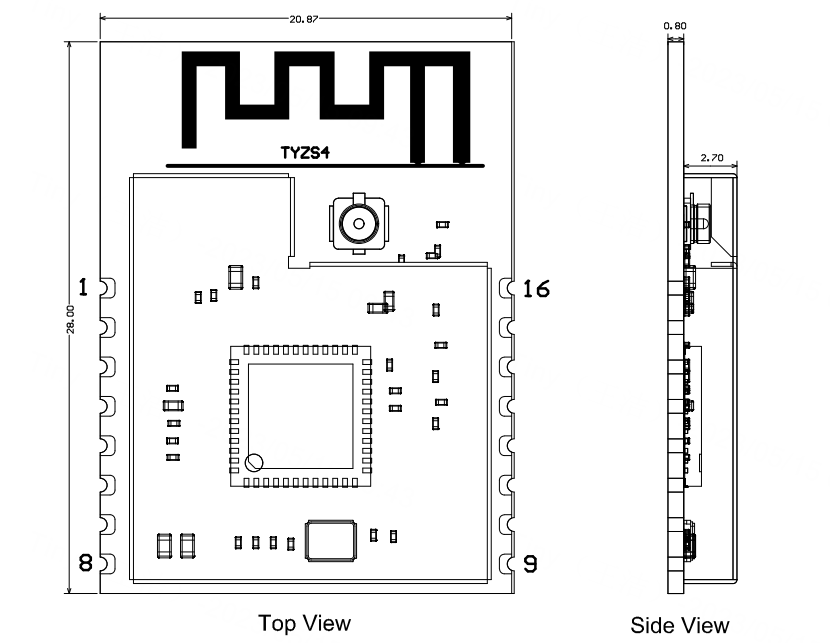
Recommended PCB packaging
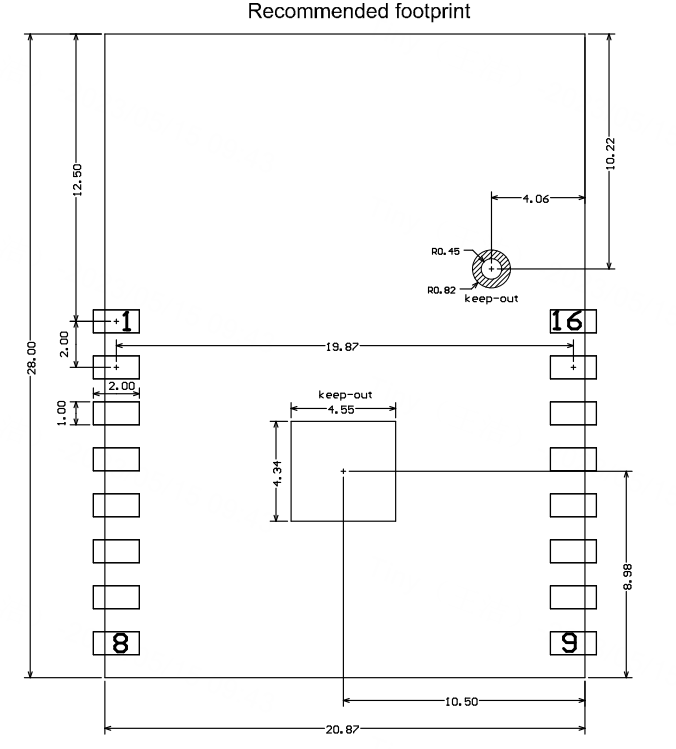
Production instructions
When TYZS4-IPEX is used as a gateway module, refer to the following wire connection:
| Module-end signal | MCU-end signal | Description |
|---|---|---|
| UART_CTS | UART_RTS | For an interface (baud: 115200) with flow control, connect to the pin. Support the default ZS4-IPEX version. For an interface (baud: 57600) with flow control, you may not connect to the pin. You need to confirm the version with the provider. |
| UART_RTS | UART_CTS | For an interface (baud: 115200) with flow control, connect to the pin. Support the default ZS4-IPEX version. For an interface (baud: 57600) with flow control, you may not connect to the pin. You need to confirm the version with the provider. |
| RX | TX | - |
| TX | RX | - |
| VCC | VCC | Power supply pin |
| GND | GND | Ground reference pin |
| nRST | GPIO | GPIO, high level by default |
| FRC_DCLK | GPIO | GPIO, a low level by default |
| PW1 (REQUEST) | STATE | PTA (not support the default version, need to confirm the version with the provider) |
| PW2 (GRANT) | ACT | PTA (not support the default version, need to confirm the version with the provider) |
| PW3 (PRIORITY) | PRI | PTA (not support the default version, need to confirm the version with the provider) |
Production instructions
- The Tuya SMT module should be mounted by the SMT device. After being unpacked, it should be soldered within 24 hours. Otherwise, it should be put into the drying cupboard where the RH is not greater than 10%; or it needs to be packaged under vacuum again and the exposure time needs to be recorded (the total exposure time cannot exceed 168 hours).
- SMT devices:
- Mounter
- SPI
- Reflow soldering machine
- Thermal profiler
- Automated optical inspection (AOI) equipment
- Baking devices:
- Cabinet oven
- Anti-electrostatic and heat-resistant trays
- Anti-electrostatic and heat-resistant gloves
- SMT devices:
- Storage conditions for a delivered module:
-
The moisture-proof bag must be placed in an environment where the temperature is below 40°C and the relative humidity is lower than 90%.
-
The shelf life of a dry-packaged product is 12 months from the date when the product is packaged and sealed.
-
There is a humidity indicator card (HIC) in the packaging bag.
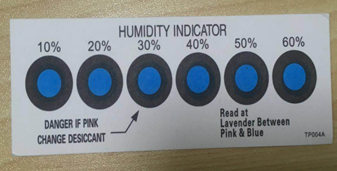
-
- The module needs to be baked in the following cases:
- The packaging bag is damaged before unpacking.
- There is no HIC in the packaging bag.
- After unpacking, circles of 10% and above on the HIC become pink.
- The total exposure time has lasted for over 168 hours since unpacking.
- More than 12 months have passed since the sealing of the bag.
- Baking settings:
- Temperature: 60°C and ≤ 5% RH for reel package and 125°C and ≤5% RH for tray package (please use the heat-resistant tray rather than plastic container)
- Time: 48 hours for reel package and 12 hours for tray package
- Alarm temperature: 65°C for reel package and 135°C for tray package
- Production-ready temperature after natural cooling: < 36°C
- Re-baking situation: If a module remains unused for over 168 hours after being baked, it needs to be baked again.
- If a batch of modules is not baked within 168 hours, do not use the reflow soldering to solder them. Because these modules are Level-3 moisture-sensitive devices, they are very likely to get damp when exposed beyond the allowable time. In this case, if they are soldered at high temperatures, it may result in device failure or poor soldering.
- In the whole production process, take electrostatic discharge (ESD) protective measures.
- To guarantee the passing rate, it is recommended that you use the SPI and AOI to monitor the quality of solder paste printing and mounting.
Recommended oven temperature curve
Perform mounting with the SMT based on the following reflow oven temperature curve. The highest temperature is 245°C. The reflow temperature curve is as below:
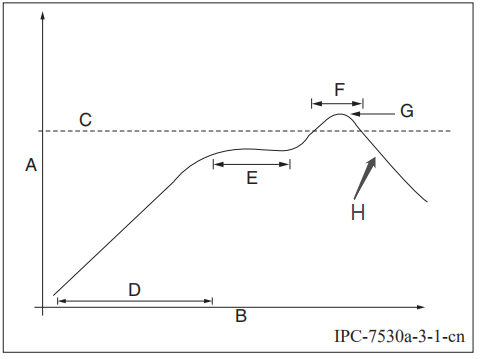
-
A: Temperature axis
-
B: Time axis
-
C: Liquidus temperature: 217 to 220°C
-
D: Ramp-up slope: 1 to 3°C/s
-
E: Duration of constant temperature: 60 to 120s; the range of constant temperature: 150 to 200°C
-
F: Duration above the liquidus: 50 to 70s
-
G: Peak temperature: 235 to 245°C
-
H: Ramp-down slope: 1 to 4°C/s
Note: The above curve is just an example of the solder paste SAC305. For more details about other solder pastes, please refer to Recommended oven temperature curve in the solder paste specifications.
Storage conditions
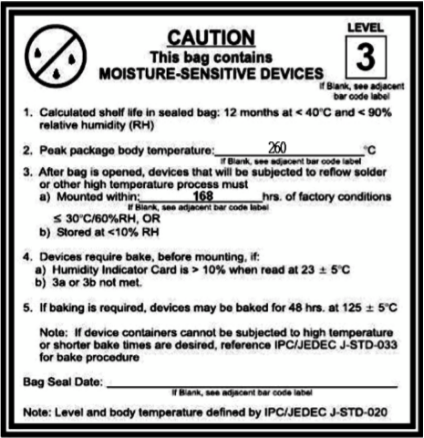
MOQ and packaging information
| Product number | MOQ (pcs) | Packing method | Modules per reel | Reels per carton |
|---|---|---|---|---|
| TYZS4-IPEX | 2800 | Tape reel | 700 | 4 |
Is this page helpful?
YesFeedbackIs this page helpful?
YesFeedback

